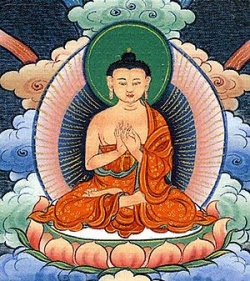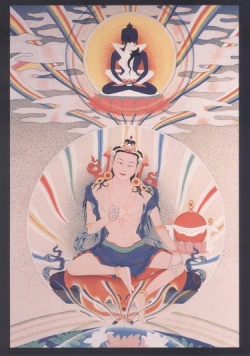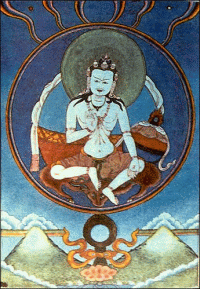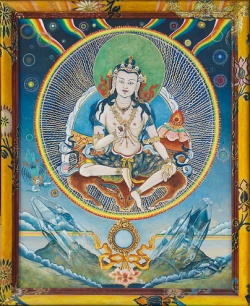Garab Dorje
Garab Dorje (Fl. 55 CE) (Tibetan:དགའ་རབ་རྡོ་རྗེ་, Wylie: dga’ rab rdo rje) 9Skt. Prahevajra (Pramodavajra/Surativajra) was the semi-historical first human teacher of the Ati Yoga (Tib. Dzogchen) or Great Perfection teachings according to Tibetan Buddhist tradition.
Prior to Prahevajra, the Nyingma hold that the Dzogchen teachings had been expounded only in celestial realms and the pure lands (Sanskrit: śuddhanivāsa) of the Buddhas, Devas and Nāgas.
The Bonpo have a different view of the entry of Dzogchen into the lineages of humanity.
The incarnation of Semlhag Chen, a god who earlier had been empowered by the buddhas.
Garab Dorje means 'Indestructible joy' Garab Dorje (6th century BCE-second century CE) (Pramoda Vajra, Ga-rang Duo-jie Sheng-xi Jin-gang, dga’ rab rdo rje): Born in Uddiyana, the birthplace of Master Padmasambhava.
Received the Great Perfection dharma directly from Vajrasattva Mahasattva and Vajrapani Bodhisattva, which he transmitted to Master Manjushrimitra and Guru Padmasambhava. Wrote Golden Letters.
The lineage of Dzogchen, unbroken to the present day, is traced from the dharmakaya Samantabhadra (‘Kuntuzangpo’ in Tibetan) to the sambhogakaya, represented by the five buddha families and Vajrasattva, and then to the first human master Garab Dorje.
It then passed to Mañjushrimitra.
At the time of his parinirvana, Garab Dorje ascended into the sky and dissolved into rainbow light.
Whereupon Garab Dorje was moved, and his hand reappeared, in which was a small golden casket, the size of a thumbnail, containing the teaching of Hitting the Essence in Three Words, which he let fall into the hand of Mañjushrimitra.
As soon as he received it, his mind became the same as the wisdom mind of his master Garab Dorje.
Nomenclature, orthography and etymology
Garab Dorje or Garap Dorje is the only attested name.
The Sanskrit offerings are reconstructions. No Sanskrit name has been found in a colophon to attest to historicity.
That said, Germano (1992: p.4) cited "Vajraprahe" in the "Direct Consequence of Sound Tantra" within the Nyingma Gyubum (NGB1 24,1) and goes on to state in the same work that John Myrdhin Reynolds (1989, 2000 revised) reverses the two words in the contraction in his translation and analysis of a section of the Bardo Thodol from Tibetan into English, specifically the Rig pa ngo sprod gcer mthong rang grol (Wylie) where he employs "Prahevajra".
Germano (1992: p.4) holds that Reynolds lexical choice of "Prahevajra" was informed by a Mantra of a short Guru Yoga text by Dzongsar Khyentse Chokyi Lodro (c.1893-1959).
Prahevajra or Pramodavajra (Tibetan: Garab Dorje, Tibetan: དགའ་རབ་རྡོ་རྗེ་, Wylie: dga’ rab rdo rje; Sanskrit: Prahevajra or Pramodavajra)
Detail
According to Tibetan Buddhism, Prahevajra transmitted the teachings to Manjushrimitra, who was regarded as his chief Disciple.
Padmasambhava is also known to have received the transmission of the Dzogchen Tantras directly from Garab Dorje.
Prahevajra received the Empowerment and transmission of the Mahayoga teachings of the Secret Matrix Tradition (Guhyagarbha Tantra) from Mahasiddha Kukuraja.
Birth
Born (as son of Su-dharmā, island-dwelling daughter of king Upa-rāja of Dhana-koṣa) in the land of Uddiyana, also the birthplace of Padmasambhava, Prahevajra is said to have received all the Tantras, scriptures and oral instructions of Dzogchen directly from Vajrasattva and Vajrapani.
Alternatively, his mother is named as Pāraņī, and located on the banks of lake Kutra.
Dargyay, et al. (1977, 1998: p. 19) conveys the hagiographic nativity of Garab Dorje as well as briefly contextualizes his mother (a bhikṣuṇī whose sadhana was Yoga tantra) and her parents;
the dream holds the vase of the Astamangala, the 'threefold world', 'oṃ ā hūṃ' and svāhā:
- The Lord of Secrets (gSang-ba'i-bdag-po) instructed the Holders of Wisdom (Rig-'dsin) in Dhanakośa in Uḍḍiyāna the contemporary Swat valley.
There was a large temple, called bDe-byed-brtsegs-pa; it was surrounded by 1608 smaller chapels. King Uparāja, and Queen sNang-ba-gsal-ba'i-od-ldan-ma resided there.
They had a daughter called Sudharmā; she took the novice vows, and soon afterwards the full monastic vows.
Sudharmā, together with her maidens, stayed on an island and meditated about the Yoga Tantra (rnal-'byor-gyi rgyud).
One night the Bhikṣuṇī Sudharmā dreamed that a white man had come, who was utterly pure and beautiful.
He held a crystal vessel in his hand which had the letters oṃ ā hūṃ svāhā engraved upon it.
Three times he set the vessel upon the crown of her head, and Light then shone from it.
While this happened, she beheld the threefold World perfectly and clearly. Not long after this dream the Bhikṣuṇī gave birth to a true son of the gods.
Testament of Prahevajra
Upon his Death, Prahevajra imparted his last testament to Manjushrimitra.
These three preceptsn as the "Three Words that Strike to the Heart of the Essential Point" or Tsig Sum Nèdek (Wylie: tshig gSum gNad brDeg) summarize the whole of the Dzogchen teachings:
- One is introduced directly to one's true nature or "Direct Introduction." (Wylie: ngo rang thog tu sPrad)
- One attains certainty about this natural state or "Remaining without Doubt." (Wylie: thag gCig thog dug Cad)
- One continues with confidence in Liberation or "Continuing in the non-dual state." (Wylie: gDengs grol thog du ’cha’)
Primary & secondary resources
Writings
Though not his writings the tradition holds that the Seventeen Tantras were directly revealed to Garab Dorje.
The following texts are attributed toGarab Dorje:
- "Cutting Through the Three Times" (Tibetan: དུས་གསུམ་ཆིག་ཆོད, Wylie: dus gsum chig chod)
- "Overwhelming the Six Modes of Consciousness with Splendour" (Tibetan: ཚོགས་དྲུག་ཟིལ་གནོན, Wylie: tshogs drug zil gnon)
- "Natural Freedom That Underlies Characteristics" (Tibetan: མཚན་མ་རང་གྲོལ, Wylie: mtshan ma rang grol)
- "Direct Encounter with The Three Kayas" (Tibetan: སྐུ་གསུམ་ཐུག་ཕྲད, Wylie: sku gsum thug phrad)
- "Vajra Fortress" (Tibetan: རྡོ་རྗེ་མཁར་རྫོང, Wylie: rdo rje mkhar rdzong)
- "Deep Immersion in Awareness" (Tibetan: རིག་པ་སྤྱི་བླུགས, Wylie: Rig pa spyi blugs)
Famous Quotes
|
Three Statements
ངོ་རང་ཐོག་ཏུ་སྤྲད། །
ཐག་གཅིག་ཐོག་ཏུ་བཅད། །
གདེང་གྲོལ་ཐོག་ཏུ་བཅའ། །
Introducing directly the face of rigpa in itself,
Decide upon one thing and one thing only,
Confidence directly in the liberation of rising thoughts.
Rigpa & Dharmakaya
གདོད་ནས་དག་པ་དབྱིངས་ཀྱི་ངང་ཉིད་ལས། །
རིག་པ་ཐོལ་སྐྱེས་སྐད་ཅིག་དྲན་པ་དེ། །
རྒྱ་མཚོའི་གཏིང་ནས་ནོར་བུ་རྙེད་པ་འདྲ། །
སུས་ཀྱང་མ་བཅོས་མ་བྱས་ཆོས་ཀྱི་སྐུ། །
"When, from out of the primordially pure Dharmadhatu,
Suddenly Rigpa arises, and with it there is an instantaneous recognition, it is
Like finding a precious jewel in the depths of the ocean,
No-one has created it - it is just the Dharmakaya".



